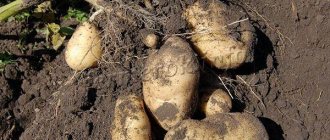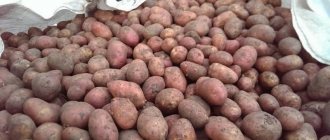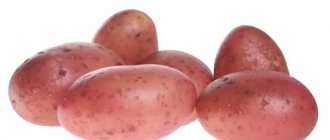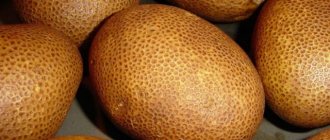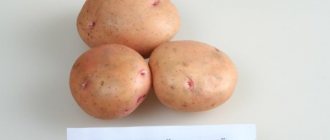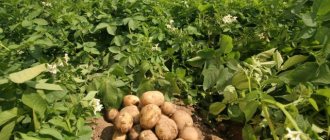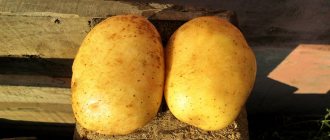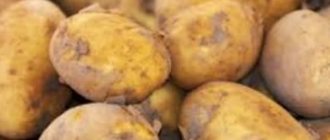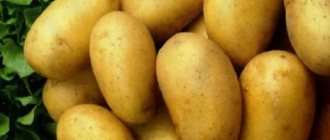Description and characteristics of the variety
The Mayak potato belongs to the category of early ripening table species, the ripening period is mid-early - harvesting is carried out 70-90 days after germination. Keeping quality 96%.
The bushes are strong, the height of the shoots is above average (within 70 cm). The stems are strong, semi-spreading, and do not lie down. The plant arrangement is semi-erect. Blooms in June, the flowers are large, painted in a soft lilac color. The foliage and branching are moderate. In 1 nest, 12-18 fairly large tubers begin and grow (the weight can reach 170 g or more). Marketability 88-91%
The variety is adapted to temperate and cool climates and is recommended for cultivation in the Volga-Vyatka region.
Features of tubers:
- average weight 97-153 g;
- starchiness 14.6-17.3%;
- the color on the outside is deep red;
- there are many eyes, 1 mm in size (located superficially);
- the skin is smooth;
- the pulp is white, dense texture;
- oval shape.
The commercial properties and taste of this variety have earned good marks from vegetable growers and chefs. The boilability is weak, which is why the tubers are rarely used for puree. Potatoes are ideal for boiling (in salads, side dishes), stewing, frying, baking. The slices do not disintegrate in soups and borscht.
High-quality seed material (elite) is presented. Tubers for planting do not weigh more than 90 g. These potatoes do not degenerate for a long time; for subsequent plantings, you can use your own material for several years.
Origin and development
Potato Mayak is a domestic variety from the line of a popular breeding creator (FGBNU Ural Research Institute). The vegetable was bred in 2013 and has been listed in the State Register since 2021. Lighthouse is actively grown in the following areas:
- Perm;
- Kirovskaya;
- Sverdlovskaya;
- Nizhny Novgorod.
The variety is cultivated on the territory of Mari El, the Chuvash and Udmurt Republics.
Features of agricultural technology
Potatoes are grown in more than one hundred countries around the world. Standard agricultural technology for growing this popular vegetable crop in Russia requires compliance with the following recommendations:
- Potatoes are planted only after the soil has warmed up to positive temperatures;
- the soil for potatoes should be loose and fertile, with sufficient aeration and water permeability;
- The scheme for planting potatoes using the shovel method assumes a distance between potato bushes and rows of approximately 50-60 cm, which allows the plants to provide sufficient nutrition area;
- Irrigation measures should be properly organized, taking into account that the standard moisture requirement of this vegetable crop during different periods of growth and development varies;
- Exceeding the standard amount of nitrogen fertilizers in the phase of active plant development can have a negative impact on the quality parameters of grown potatoes, therefore fertilizing with such means should be replaced with the application of organic matter and mineral fertilizers.
When growing the Mayak potato variety, it is advisable to adhere to the standard rules presented.
Article on the topic: Potato variety “Music” - description and photo
After reading the corresponding article on our website, you can also learn about the varietal characteristics of high-yielding potatoes “Udacha”.
Growing and care
The variety grows well on different soils, but the ideal soil is loose soil with fertilizers. You can add rotted compost, urea, and nitrophoska. Plants are placed at a distance of 30 cm in a row, with a row spacing of 70 cm.
They begin to water as soon as 2 weeks have passed after germination, then moisten 2 more times during the flowering stage. The moisture level per 1 m2 varies between 20-35 liters. The variety needs 2 hillings (when the tops are 10 and 20 cm long). The height of the embankment is no more than 2/3 of the length of the stems. The soil is raked from between the rows using a hiller, plow, or walk-behind tractor.
Correct fit
When growing Mayak, standard agricultural practices are followed, which include:
- Potatoes are planted only when the soil warms up to +8-10 C.
- Tubers should be planted in a sunny, well-ventilated area. Also, special attention is paid to the soil. It must be fertilized (the soil is fed in the fall) and loose.
- There should be no weeds on the site. It inhibits the crop, thereby slowing down the development of root crops.
- During planting, about 60-70 cm are left between the rows, and about 35-40 cm between the holes. Such large row spacing is needed for at least several reasons. Firstly, the larger the row spacing, the more convenient it will be to carry out hilling. Secondly, this ensures good natural aeration and illumination.
- The planting depth in light sandy loam soils should not exceed 10 cm. In heavier soils, the tuber planting depth is reduced to 5-6 cm.
- If the soil is well fertilized in the fall, then, in general, there is no need to carry out additional fertilizing. However, if it is poor in organic matter or has a very complex structure, then it is necessary to add ash to each hole during planting of the material. If there is no ash, you can use any other fertilizer; in particular, humus is perfect.
Related article: Potato variety “Bellaprima” - description and photo
Proper care
Caring for potatoes is quite simple. This is not a capricious culture that makes no supernatural demands. To get a good harvest, you only need to periodically water the bushes, loosen the soil on the site and hill up the bushes. As for fertilizers, everything is simpler than it seems. If the garden was well fertilized in the fall, then this is quite enough to completely abandon further fertilizing.
Watering
Water the potatoes according to the standard scheme:
- Before the tops appear, they try not to water the plantings, since such procedures can only worsen the growing season of the crop.
- The first watering is carried out after the green part appears on the surface of the site.
- The second time the potatoes are watered immediately after the inflorescences appear. This watering is the most necessary.
- The last watering is carried out before or immediately after the end of flowering.
It is worth noting the fact that the variety is not early ripening. For this reason, after the end of flowering, it is advisable not to water the Lighthouse, as there is a risk of the crop becoming infected with late blight, which becomes active during this period of time.
Hilling
The most important agrotechnical procedure with which you can increase productivity by 20-30%. This is achieved through the formation of new stolons.
In addition, hilling performs a number of other functions:
- When hilling, the soil is loosened, thereby becoming saturated with oxygen.
- Thanks to this agrotechnical procedure, weeds can be removed from the site.
- When hilling, a mound is created, which makes the bush less spreading (especially important for tall potato varieties).
Loosening
You need to constantly loosen the soil. This does not mean that this procedure needs to be carried out every day. Typically, experienced summer residents loosen the soil after watering or rain. It is at this time that the soil becomes less loose and its oxygen transmission capacity, necessary for the good development of tubers, deteriorates.
Features of planting and growing
To grow the variety, choose well-lit areas with fertile soil. The soil should be breathable and loose. In compacted soil, the tubers will become deformed.
Potatoes grow well in slightly acidic or neutral soil. If the acidity of the soil is high, wood ash is added to it when digging.
Preparing for landing
For planting, healthy, smooth, uniform tubers of the same size are selected, without mechanical damage. 20-30 days before planting, the tubers are germinated by placing them in clean containers in two layers and placing the containers in a warm room.
Before germination, potatoes are kept in a solution of Fitosporin and a weak blue solution of copper sulfate to prevent the formation of fungal diseases during the growing season. Potatoes with formed sprouts are re-sorted before planting.
Attention! Tubers on which sprouts have not appeared are not suitable for planting.
When the length of the sprouts reaches 1-1.5 cm, planting in open ground begins. To stimulate growth, before planting, planting material is sprayed with a solution of Epin or Zircon (4 drops of the drug per 1 liter of water).
Soil requirements
The variety is grown on any type of soil, but the best results are achieved on well-prepared, fertile, loose soil. A good harvest can be obtained when grown in black soil and turf soil.
To form a large number of tubers, the variety requires soil with the necessary amount of nutrients. Therefore, organic matter and mineral fertilizers are added to the canopy when digging up the site.
Dates, scheme and rules of planting
Planting of prepared tubers begins at the end of May, after the soil has warmed up to +10°C to a depth of 12-15 cm. Planting dates vary in different areas depending on the onset of heat in the region.
For potato beds, choose a well-lit area. Three weeks before planting, the soil is dug up with the addition of urea and wood ash. When planting, it is useful to pour 100 g of compost into each hole.
Attention! Cow manure is not used during and after planting, as fresh organic matter will cause burns to young shoots.
The holes are placed at a distance of 28-30 cm from each other. A gap of 60-70 cm is left between the rows. The sprouted tubers are carefully placed to a depth of 8-10 cm so as not to damage the sprouts. Sprinkle with loose soil on top.
At first, when the temperature drops at night, the potato beds are covered with film if necessary.
Features of cultivation
To protect against wireworm invasion, potatoes are planted after cereals, legumes, annual grasses, and lupine.
When planting, wide row spacing (60-70 cm) is left for ease of agricultural work, for better lighting and aeration of the bushes.
Important! The depth of planting tubers depends on the composition of the soil. In turf soil and chernozem, tubers are planted to a depth of 6-7 cm, in light sandy loam soils - at 10-12 cm.
Before planting, be sure to check the depth of groundwater. The water level should be at least 75-80 cm from the soil surface.
The soil for planting potatoes begins to be prepared in the fall. All plant residues and weeds are carefully removed, the soil is dug deep, and organic matter and mineral fertilizers are simultaneously applied.
The main nuance in growing this variety is its need for good soil moisture. When watering, it should be taken into account that the need for moisture changes during the growing season.
Good results are obtained by mulching the beds . A layer of 6-7 cm will prevent weeds from growing and protect the soil from drying out.
Watering mode
Before emergence, the soil is not moistened, since watering during this period will lead to superficial growth of the root system.
The first watering is carried out when the young tops reach 6-7 cm in height. Water the seedlings with small portions of warm water under each bush. In this case, it is necessary to ensure that the water does not wash the tubers onto the surface. About 2 liters of water are poured under each plant.
Before flowering, potatoes are watered depending on the dryness of the soil, on average - once every 8-9 days.
Reference. If the site has sandy soil, water more often, since such soil dries out faster than turf and black soil.
During the flowering period of the crop, plants require more moisture, since tubers form during this period. If there is a lack of moisture, there will be few tubers and they will not grow to the proper size.
During the formation of tubers, 9-10 liters of water are spent on each bush. Watering is carried out every three days in the morning or evening, preferably by sprinkling. After flowering ends, the volume of liquid is increased to 15 liters.
Harvest and storage
Potatoes planted at the end of May are fully ripened in September. For harvesting, choose dry weather so that it is convenient to remove the potatoes with a pitchfork, since it is difficult to dig in wet soil.
The dug up potatoes are dried, sorted and stored. Under proper conditions, the crop retains its presentation and taste until the next season.
How and when to collect
The term is determined by the appearance of the lower leaves on the tops. Yellowing of the foliage indicates that the potatoes are fully ripe. When all the tops turn yellow, harvesting begins.
To avoid damaging the tubers with a shovel, a pitchfork is preferred. The bush is lifted by the tops, the soil is shaken off and transferred to the prepared room.
Storage features and keeping quality of the variety
The collected potatoes are laid out on a dry surface in a dark room for 7-10 days to dry. The air temperature in the room is maintained at +14…+17°C. The room is regularly ventilated.
After drying, the potatoes are sorted. Tubers damaged by rot and dry are thrown away. Potatoes with mechanical damage during digging are selected for consumption first. The good ones are placed in long-term storage.
A microclimate is created in the vegetable storage with an air temperature of +3...+5°C, humidity 85-90% and regular air circulation. If the recommended conditions are met, the Mayak variety can be stored for 7-8 months. Keeping quality reaches 97%.
